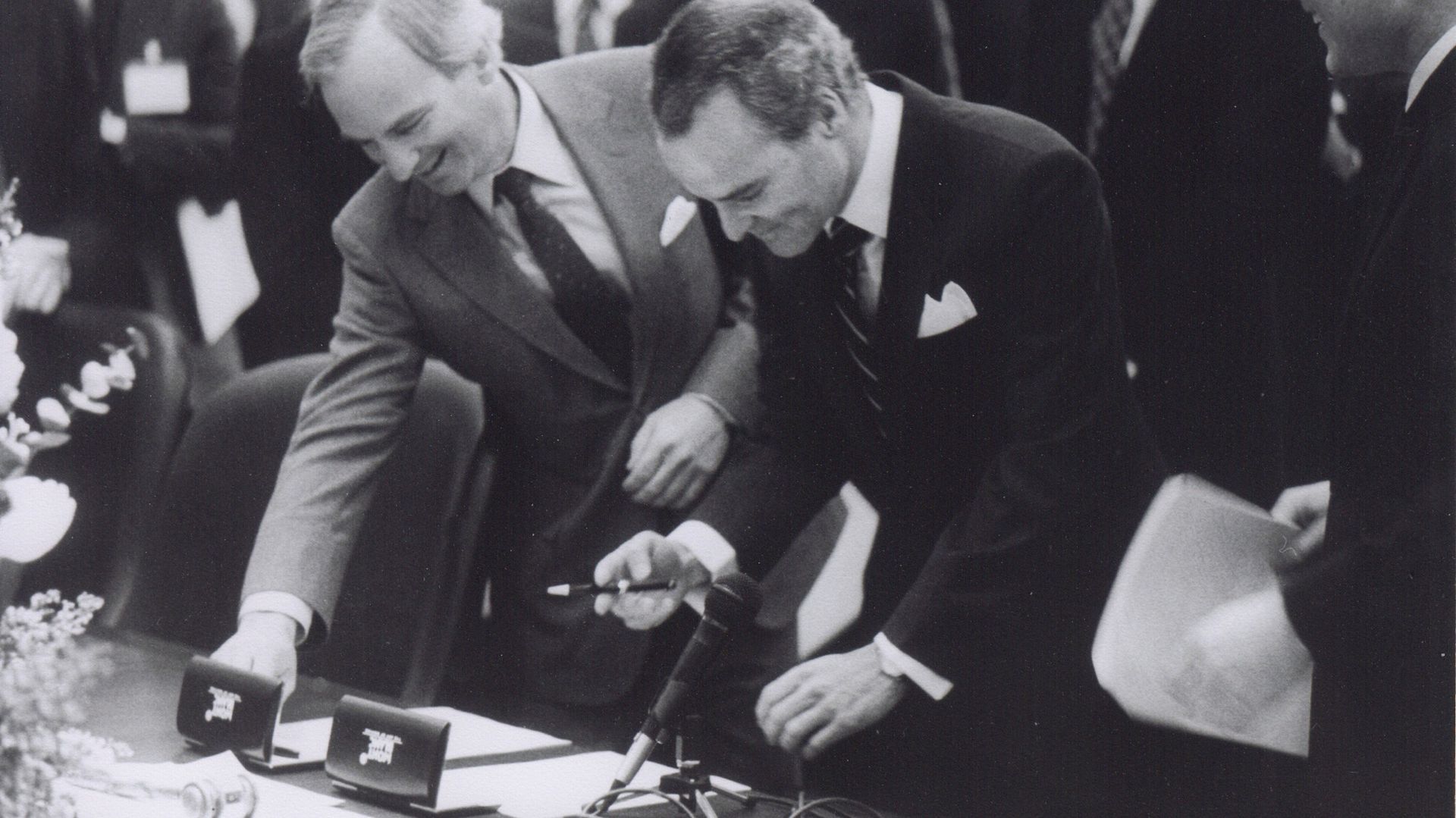尊敬的用户您好,这是来自FT中文网的温馨提示:如您对更多FT中文网的内容感兴趣,请在苹果应用商店或谷歌应用市场搜索“FT中文网”,下载FT中文网的官方应用。


Consider the tale of two $20bn-something companies — both of them private equity buyouts.
想想两家200亿美元左右的公司的故事——都是私募股权收购。
Thirty-five years ago, when Kohlberg Kravis Roberts pounced on the food-to-tobacco conglomerate, RJR Nabisco, the private equity industry hit mainstream headlines for probably the first time. The scale of that $25bn Nabisco deal — immortalised in the bestselling business book Barbarians at the Gate — is still totemic. (It dwarfs last year’s biggest global buyout — the $14bn paid for Toshiba by Japan Industrial Partners).
35年前,科尔伯格-克拉维斯-罗伯茨集团(KKR)收购了业务涵盖食品烟草的企业集团雷诺兹-纳贝斯克(RJR Nabisco),私募股权投资行业可能是在此时第一次登上主流媒体的头条。250亿美元的纳贝斯克交易的规模至今仍有图腾意义——该协议被商业畅销书《门口的野蛮人》(Barbarians at the Gate)载入史册。(它使去年最大的全球收购案——日本产业合作伙伴公司(JIP)为东芝(Toshiba)支付140亿美元——相形见绌)。
But in most other respects, private equity has been transformed over the past three decades. In 1989, it was still essentially a cottage industry — aggregate annual deal volumes from the 1980s until the end of the century rarely topped 1 per cent of GDP, even in the US, according to the OECD. Over the past four years, that ratio has ranged between 2 and 5 per cent, PitchBook data suggests. The intervening period witnessed vast leverage-fuelled expansion underpinned by an unprecedented era of ultra-low interest rates.
但过去三十年间,私募股权投资在大多数其他方面发生了巨大变化。1989年,私募股权投资基本上还是家庭作坊产业——根据经合组织(OECD)的数据,从1980年代到上世纪末,即使在美国,每年的总交易量也很少超过国内生产总值(GDP)的1%。PitchBook的数据显示,在过去四年里,这一比例在2%到5%之间。期间,在前所未有的超低利率时代的支撑下,该行业出现了大规模的杠杆扩张。
Few deals were more aggressive than KKR-Nabisco. But the most famous buyout in history soon became the most infamous. Over a 15-year period, as tobacco risks mounted and debt costs ballooned, the original deal rationale broke down. Ultimately KKR lost $730mn on the transaction.
很少有交易比KKR-纳贝斯克更激进。但历史上最著名的收购很快就变成了最臭名昭著的收购。在长达15年的时间里,随着烟草风险的增加和债务成本的膨胀,最初的交易原理崩溃了。最终,KKR在这笔交易中损失了7.3亿美元。
Plenty of other companies have been ransacked over the years, often highly successfully for their private equity owners. But the industry today cannot be caricatured homogeneously as short-termist, debt-addicted asset-strippers.
多年来,还有许多其他公司被洗劫一空,往往让私募股权所有者获得巨大成功。但是,今天的行业不能被简单地描述为短期主义者、负债累累的资产掠夺者。
Take the case of Visma, another $20bn company owned by private equity. First taken private by London-based HG, with an enterprise value of about $500mn in 2006, the Nordic software business is now reckoned to be worth 40 times that — and is still majority owned by HG. The 18-year recent history of Visma’s ownership is also, in exaggerated form, the story of private equity’s broader evolution — and in multiple ways.
以Visma公司为例,这是另一家由私募股权投资公司拥有的价值200亿美元的公司。这家北欧软件企业最初于2006年被总部位于伦敦的HG公司私有化,当时的企业价值约为5亿美元,现在的价值估计是当时的40倍,而且仍由HG公司持有多数股权。Visma公司最近18年的所有权历史,也以夸张的形式,从多个方面讲述了私募股权投资的广泛演变。
One trend it reflects is longer hold times. In the 1990s or 2000s, a typical private equity firm would have been in and out of a deal in three or four years. Last year, the median hold time for the 1,121 companies that were sold was 6.4 years, an all-time record, according to PitchBook. This is due in part to a maturing model that goes beyond adding debt and cutting jobs. But it is also driven by private equity’s use and abuse of so-called continuation funds to extend investment horizons — either because they want to hold on to thriving portfolio companies for longer, or because they don’t want to crystallise weak valuations of underperformers.
它反映的一个趋势是持有时间延长。在1990年代或2000年代,一般的私募股权投资公司会在三四年内完成交易。根据PitchBook的数据,去年出售的1121家公司的中位持有时间为6.4年,创下历史纪录。这在一定程度上是由于公司模式日趋成熟,而不仅仅是增加债务和裁员。但这也是私募股权利用和滥用所谓的延续基金来延长投资期限的结果——这可能是因为他们想更长时间地持有茁壮成长的投资组合公司,也可能是因为他们不想将业绩不佳公司的疲软估值固化下来。
Selling these days is tricky — particularly into public markets that are no longer receptive to listings of highly leveraged companies with inflated private valuations. Even in the voguish technology sector, the few examples of initial public offerings by private equity-owned companies have been cautionary. (Instacart in the US is down 25 per cent since last year’s float, and Deezer in Europe is down nearly 60 per cent.) Private equity exits via IPOs, once the norm, accounted for barely 1 per cent of exits in the US and Europe last year, the PitchBook data shows.
如今,出售是一件棘手的事情,尤其是在公开市场上,因为这些市场不再接受私人估值虚高的高杠杆公司上市。即使是在风光无限的科技领域,私募股权公司控股的企业进行首次公开发行(IPO)的少数例子也令人警惕。(美国的Instacart自去年上市以来下跌了25%,欧洲的Deezer下跌了近60%)。PitchBook的数据显示,私募股权通过首次公开发行退出曾经是常态,但去年在美国和欧洲仅有1%。
A second trend that HG’s ownership of Visma illustrates is the shift towards multiple investors. Collaboration between private equity firms has been an on-and-off feature of the sector for decades, notably via so-called club-deals when firms pool resources in an effort to take ever bigger targets private.
HG控股Visma说明的第二个趋势是向多投资者转变。几十年来,私募股权投资公司之间的合作一直是该行业时有时无的特点,特别是通过所谓的俱乐部交易,即公司集中资源,努力将更大的目标私有化。
But a new style of joint investment has also been growing, exemplified most obviously by HG. In the case of Visma, the firm has brought in a new roster of investors every three or four years — either fellow private equity firms, or their end-investor “limited partners” directly. The Norwegian group now has more than 30 investors. PitchBook data shows that deals over the past four years, involving six or more investors, have multiplied 162 per cent compared with the prior four-year period, while standard single-investor deal volumes are up only 28 per cent.
但一种新的联合投资方式也在发展壮大,HG就是最明显的例子。以Visma公司为例,该公司每隔三四年就会引入一批新的投资者——要么是其他私募股权投资公司,要么直接是其最终投资者的“有限合伙人”。这家挪威集团目前拥有30多家投资者。PitchBook的数据显示,过去四年中,涉及六位或六位以上投资者的交易量比前四年翻了162%,而标准的单一投资者交易量只增长了28%。
Of course every investor needs an exit at some point. Recognising that short-term IPOs might not be realistic, stock exchanges from Nasdaq to the London Stock Exchange are innovating with platforms that will make it easier for investors in private companies to auction their holdings. The LSE’s “intermittent trading venue”, which is already wooing the likes of HG and Visma, may be one forward-thinking way to begin offsetting the string of delistings it has suffered of late.
当然,每个投资者都需要在某些时候退出。由于认识到短期IPO可能不太现实,从纳斯达克到伦敦证券交易所都在创新平台,使私人公司的投资者更容易拍卖所持股份。伦敦证券交易所的“间歇性交易场所”已经吸引了像HG和Visma这样的公司,它可能是一种具有前瞻性的方式,可以开始抵消它最近遭遇的一系列退市。
patrick.jenkins@ft.com
patrick.jenkins@ft.com